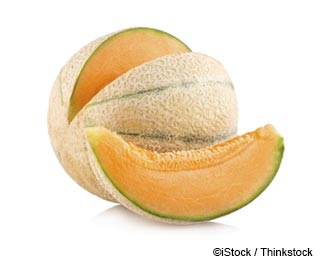Cantaloupe Tales
Botanical name: Cucumis melo reticulatus

"Succulent" perfectly describes the juicy flesh of the peachy-orange cantaloupe, one of the most refreshing summer fruits. It's a member of the cucurbit family (Cucurbitaceae) of plants, along with cucumbers, pumpkins, gourds and other melon varieties, like honeydew.1
Cantaloupe's cultivation is widespread throughout the world, including Asia and Europe.2 In the U.S., California has the highest production of this fruit,3 although they still import from Central America because consumption is high and it's a warm-season crop.4
Sometimes, it's difficult to know when cantaloupes are ready for consumption, but there are a few clues. When ripe, they're inordinately heavy, the stem end gives just a bit when pressed with your thumb (too much and it may be overripe) and a firm knuckle rap will produce a low and rather hollow sound.5
Before you cut the fruit open, thoroughly wash the outer skin with a clean brush under running water. Once sliced, place in a container in the fridge at a temperature of 41 degrees Fahrenheit or lower.6 Cantaloupe is tasty when chopped up and mixed with other fruits, such as watermelon, honeydew and a few strawberries and blueberries thrown in for a colorful breakfast, brunch or snack.
Many people recognize cantaloupe by its tough, net-like, reticulated rind (hence the botanical name). However, this may actually be a muskmelon. True cantaloupes (Cucumis melo var cantalupensis) don't usually have the even-patterned netting, and have deep, end-to-end grooves like a basketball. Both types are referred to as cantaloupe in the U.S.7
Health Benefits of Cantaloupes
Like other plant-based foods, cantaloupes have unique nutritional attributes. These include fiber, niacin, vitamin B6, folate and one of the highest sources of vitamin A of any fruit, while being low in sodium, fat and cholesterol.8 Manganese, a co-factor for the enzyme superoxide dismutase,9 is essential for maintaining strong antioxidant defense,10 good vision11 and healthy skin,12 and is a known protectant against lung and mouth cancers.13
In addition to providing an excellent source of vitamin C (36 milligrams per 100 grams) to defend the body against infection,14 cantaloupes are also a wonderful source of potassium, which helps control heart rate and blood pressure15 and helps protect against stroke and coronary heart diseases.16 Cantaloupe is also abundant in antioxidant flavonoids, such as beta-carotene, and lutein and zeaxanthin,17 which are carotenoids absorbed into the retina, where scientists believe they may provide light-filtering functions to protect against age-related macular degeneration.18 The flavonoid cryptoxanthin shields cells and other areas of the body from free radicals,19 and may ultimately help inhibit colon and lung cancers.20
Be sure to consume cantaloupes in moderation, as they contain fructose, which may be harmful to your health in excessive amounts. Cantaloupes, like other members of the Cucurbitaceae family, also contain lectins, which are plant proteins that may have a detrimental effect on your gut microbiome. To avoid this, peel and deseed your cantaloupes before cooking them. Learn more about lectins here.
You should also strive to buy organic cantaloupes, as they are also one of several foods often contaminated by toxic insecticides, and ranks at no. 38 in the Environmental Working Group's 2020 Shopper's Guide to Pesticides in Produce list.21
Cantaloupe Nutrition Facts
Serving Size: 3.5 ounces (100 grams), raw22
| Calories |
34 |
|
| Total Fat |
0.19 g |
|
| Saturated Fat |
0.05 g |
|
| Trans Fat |
|
|
| Cholesterol |
0 mg |
|
| Sodium |
16 mg |
|
| Total Carbohydrates |
8.16 g |
|
| Dietary Fiber |
0.9 g |
|
| Sugar |
7.86 g |
|
| Protein |
0.84 g |
|
| Calcium 9 mg |
Iron |
0.21 mg |
Studies Done on Cantaloupes
One study determined that cantaloupes have as much as 60% more β-carotene than honeydew melons.23 Other research was conducted to evaluate the superoxide dismutase (an enzyme that repairs cells and reduces damage by superoxide, the most common free radical in the body) activity in cantaloupe extracts. Results indicated the importance of superoxide dismutase activity for the antioxidant and anti-inflammatory properties offered by eating cantaloupe, preserved during the digestive process.24
Another study found cantaloupe to be one of several fruits and vegetables specifically linked with lowered breast cancer risk.25
Cantaloupe Healthy Recipes:
Vegan 2-Ingredient Cantaloupe Ice Cream

|
Ingredients:
|
|
✓ 1/4 cantaloupe melon
|
✓ 1 banana
|
Procedure:
- Slice the banana and the cantaloupe, disposing the seeds and skin in pieces. Place them in a Ziploc bag and freeze them overnight.
- Put the frozen fruits in your food processor or high-speed blender and pulse or blend until completely smooth. (Depending on the power of your processor, this may take a while.)
- Transfer the ice cream to the bowls and enjoy immediately!
This recipe makes 2 servings.
(Recipe adapted from Elephantastic Vegan26)
Cantaloupe Fun Facts
The name of this fruit originated in Cantaloupo, Italy, where seeds were brought from Armenia in the 14th century for cultivation in the Pope's gardens.27
Summary
In addition to being cousins to cucumber and squash, cantaloupes are one of the garden's most refreshing delights, containing notable nutritional qualities. Vitamins A and C serve up eye protection, and amazing antioxidant and anti-inflammatory capabilities, respectively. These compounds may help inhibit several types of cancers.
A healthy serving of cantaloupe imparts a greater amount of body-beneficial nutrients, so remember: When you're passing around the cantaloupe, don't worry about the carotenoids and flavonoids — they're in there.